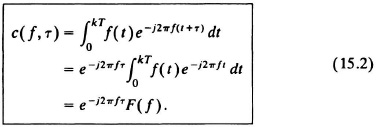15
Two-Dimensional Processing
15.1. INTRODUCTION
In Chapters 7–14 we concentrated on the use of one-dimensional acousto-optic cells used for processing wideband time signals, and we showed how multichannel versions of these devices are used to perform certain two-dimensional operations. The emphasis in this chapter is on the use of two or more acousto-optic cells, generally in orthogonal configurations, to more fully use the second dimension of the optical system. More powerful signal-processing operations are therefore possible. We describe both coherently and incoherently illuminated systems used in applications such as correlation, spectrum analysis, and range/Doppler processing (127–131).
In previous chapters we showed that the correlation between two signals is a powerful and useful operation. For example, we showed how a one-dimensional acousto-optic cell processor, as shown in Figure 14.8, is used to form the correlation function
![]()
where T is the time duration of the acousto-optic cell and kT is the integration interval. The correlation function reveals the degree of similarity between two signals and, in a general way, can be extended to include spectral analysis of signals. For example, if s(t) = exp[−j2πft], we find that

When we detect the squared magnitude of the correlation ...
Get Optical Signal Processing now with the O’Reilly learning platform.
O’Reilly members experience books, live events, courses curated by job role, and more from O’Reilly and nearly 200 top publishers.

